MARINA FRANCESE
- PORTAEREI -
PORTAERE CHARLES DE GAULLE (R91)
- AIRCRAFT CARRIER CHARLES DE GAULLE (R91) -
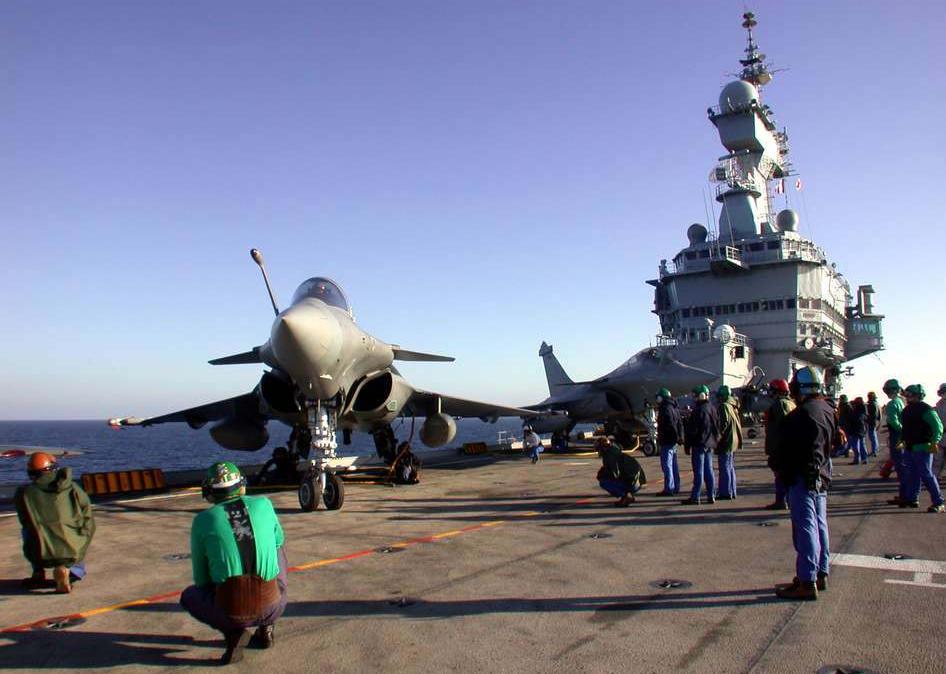
STORIA / HISTORY
|
CHARLES DE GAULLE (R91) |
Durante i mesi di luglio ed agosto del 1997 sono iniziate le prove delle catapulte della De Gaulle nel cantiere di costruzione di Brest. Queste prove consistono nel lancio di zavorre che rappresentano il peso degli aerei adatti ad operare sul ponte di volo (Rafale, Super Etendard Modernise, E2C Hawkeye). Il risultato delle prove Ŕ stato soddisfacente, Ŕ stata raggiunta una velocitÓ di 300 Km all'ora ed Ŕ stato lanciato un peso massimo di 32 tonnellate. La De Gaulle Ŕ l'unica portaerei convenzionale ad essere costruita attualmente in Europa. E' provvista di 2 catapulte costruite dalla DCN in Francia su licenza USA. Le prove di navigazione sono state fatte nel 1998, dal 2000 la portaerei Ŕ operativa |
La costruzione della Charles de Gaulle inizi˛ il 25 novembre 1987.
La costruzione dello scafo fu iniziata nell'aprile del 1989 presso i cantieri navali della Direction des Constructions Navales Services di Brest. La portaerei Ŕ stata completata nel maggio 1994 e con le sue 42.500 tonnellate, Ŕ stata la pi¨ grande nave da guerra lanciata nell'Europa occidentale dopo la HMS Ark Royal (R09) nel 1950.
La nave Ŕ stata chiamata Richelieu nel 1986 in memoria del famoso politico francese Armand Jean du Plessis, duca e cardinale di Richelieu (una denominazione tradizionale per le grandi navi della marina francese), ma Ŕ stata rinominata Charles de Gaulle l'anno successivo da parte dell'allora Primo Ministro, il gollista, Jacques Chirac.
La costruzione della Charles de Gaulle (R91) cost˛ 3 miliardi di euro (20 miliardi di franchi).
La portaerei Ŕ entrata in servizio attivo il 18 maggio 2001 ed ufficialmente armata.
La portaerei sostituý la Clemenceau (R 98), una portaerei a propulsione convenzionale, nel 2001. La Clemenceau (R 98), ritirata dal servizio nel 1998, e la Foch (R 99), ritirata dal servizio nel 2000, erano due portaerei della Classe Clemenceau, entrate in servizio rispettivamente nel 1961 e nel 1963 e fin dalla metÓ degli anni settanta si ricerc˛ una nuova portaerei che potesse sostituirle.
Nel 1993 un gruppo di agenti dell'MI6, furono scoperti mentre, travestiti da ingegneri, ispezionavano lo scafo della nave in costruzione. Si crede che stessero studiando il metodo utilizzato dagli ingegneri francesi per schermare i reattori atomici.
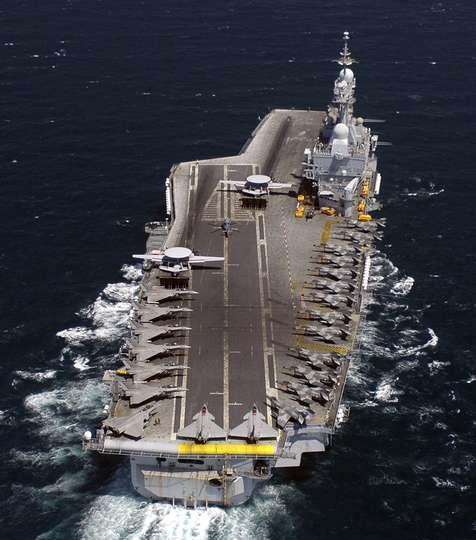
Le prime prove in mare della Charles de Gaulle nel gennaio 1999 evidenziarono la necessitÓ di prolungare il ponte di volo obliquo per permettere l'appontaggio dei Grumman E-2 Hawkeye (24 metri di apertura alare) con maggiore sicurezza, in effetti, la portaerei era originariamente dimensionata per accogliere aerei pi¨ piccoli (15 m. di apertura alare) tipo Breguet Br.1050 AlizÚ o i Dassault Rafale. Questa operazione fu negativamente percepita dalla popolazione francese, mentre:
Questo tipo di modifiche al ponte di volo ed agli impianti d'aviazione Ŕ perfettamente normale sulle navi di questo tipo previste per funzionare 40 o 50 anni, con sistemi in evoluzione continua ed ad un ritmo rapido e quindi Ŕ auspicabile che le navi portaerei possano convenientemente adattarsi a questi cambiamenti.
Gli stessi lavori erano stati realizzati sulla Clemenceau (R 98) e sulla Foch (R 99) quando fu messo in servizio il Vought F-8 Crusader.
I cinque milioni di franchi spesi per l'allungamento (di 4,6 m.) necessario alla modifica delle lamiere del ponte di volo e del guscio rappresentava soltanto lo 0,025% del bilancio totale del progetto Charles de Gaulle (R 91).
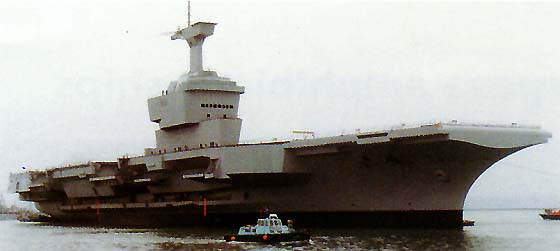
Nel corso dei lavori degli studi finali e di costruzione, la decisione fu presa di mettere in conformitÓ la protezione radiologica con le ultime norme della Commission internationale de protection radiologique in vigore, rese applicabili nel frattempo. Questo richiese modifiche limitate delle protezioni radiologiche vicino ai reattori.
Il 28 febbraio 2000, nel corso di una prova a un reattore nucleare, una combustione degli elementi protettivi radiologici vicina al reattore causarono l'emissione di fumo spesso rimasto contenuto dentro il recinto dei reattori. Per essere efficace il materiale - del legno compresso inzuppato di boro e di altri componenti dunque sensibile alla temperatura - deve essere vicino ai recinti caldi del reattore. Il suo posizionamento pi¨ preciso all'assemblaggio e il miglioramento della sua protezione termica ha risolto il problema.
Il 16 settembre 2001, la stampa francese riport˛ che livelli di radioattivitÓ in gran parte anormali erano stati misurati a bordo della Charles de Gaulle. Questo annuncio Ŕ probabilmente dovuto ad un errore di interpretazione dei mass media.
Durante la notte del 9 novembre 2000, mentre la portaerei incrociava nell'Atlantico occidentale, verso Norfolk, in Virginia, l'elica di babordo si ruppe, e la nave dovette tornare a Tolone per sostituire l'elemento difettoso. L'indagine che seguý mise in evidenza che le eliche di sostituzione comportavano gli stessi difetti di struttura: bolle (bolle che si verificano in occasione del raffreddamento del metallo colato nello stampo) vicino al centro delle eliche (fatto da un unico pezzo in una lega di rame e alluminio); questo difetto Ŕ dovuto al fornitore Atlantic Industries, che aveva fatto tagli al personale pi¨ esperto. Va notato che sulle navi di questo tipo le rotture delle pala dell'elica non Ŕ un evento raro. Sono state utilizzate, per sostituirle, le eliche meno perfezionate della Foch e della Clemenceau, cosa che ha limitato la velocitÓ massima a 25 nodi, invece dei 27 nodi previsti (ci˛ non ostacola le operazioni aeree). Il 5 marzo 2001, la Charles de Gaulle riprese il mare con le due vecchie eliche, e in prova realizz˛ velocitÓ massime a 25,2 nodi. Le vecchie eliche sono sostituite a fine maggio 2008 da due eliche realizzate dalla Rolls-Royce Marine Power Operations da 20 tonnellate e di 6 metri di diametro, fabbricate negli Stati Uniti, che permettono di accogliere i Rafale M, il cui appontaggio in una situazione difficile richiede una portaerei che navighi a 27 nodi.
Tra luglio e ottobre 2001, la Charles de Gaulle ha dovuto essere riparata a causa di rumore di 100 dB vicino all'elica di tribordo, che rendeva inabitabile la poppa. Va considerato che Ŕ abbastanza normale che le navi vibrino alle alte velocitÓ.

Mentre gli Stati Uniti preparano la loro risposta al 11 settembre 2001 con la missione Enduring Freedom, i media francesi lamentano la mancanza di potenza militare dispiegabile. Allo stesso tempo, la Commissione della Difesa ha riferito che la manutenzione della flotta era di cattiva qualitÓ. In questo contesto, la Charles de Gaulle, quindi allora in riparazione, era nuovamente l'oggetto di critiche. Ex presidente ValÚry Giscard d'Estaing ha parlato di un mezza portaerei. Questo non ha impedito alla Charles de Gaulle di partecipare attivamente alla missione Heracles nell'Oceano Indiano.
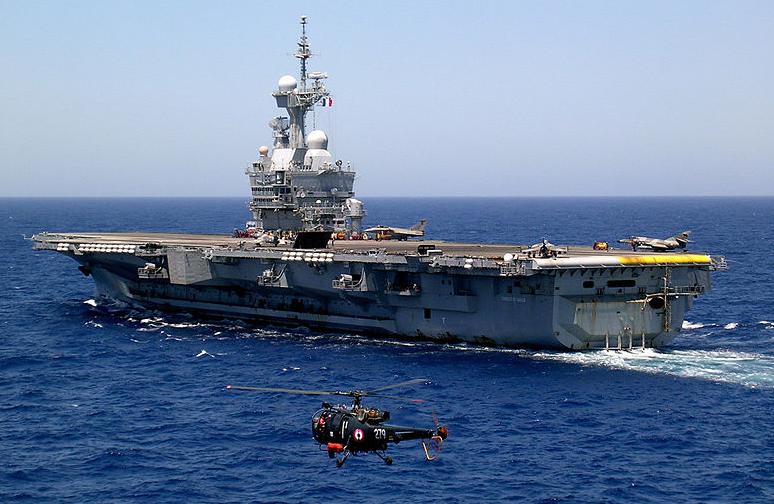
In data 11 ottobre 2001, la fregata Cassard (D 614), quattro aerei AWACS e la Charles de Gaulle hanno partecipato ad una prova di Liaison 16 (il nuovo standard di connessione della NATO). La rete consente il monitoraggio in tempo reale dello spazio aereo a sud dell'Inghilterra fino al Mar Mediterraneo. I dati raccolti sono stati anche trasmessi in tempo reale alla fregata gemella Jean Bart (D 615) attraverso il vecchio sistema di Liaison 11.
L'8 novembre 2001, un marinaio che effettuava un'operazione di manutenzione di routine di una valvola legata ai serbatoi d'acqua perse conoscenza a causa della presenza di gas tossico. Un sottoufficiale della marina tent˛ spontaneamente di aiutarlo ma perse i sensi a sua volta. Furono immediatamente aiutati dal gruppo medico di bordo ed inviati a l'ospedale di Tolone. Tutti e due sono sopravvissuti.
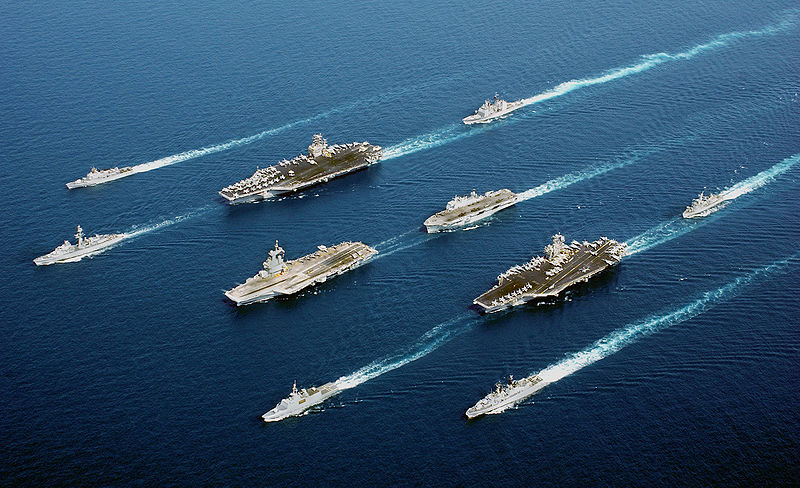
Afghanistan: Mission HÚraclŔs
Il 21 novembre 2001, la Francia decise di inviare la Charles
de Gaulle nell'Oceano Indiano a sostegno delle operazioni NATO in Afghanistan.
La Task Force 473, con 2.900 uomini sotto il comando del contrammiraglio
Franšois Cluzel salp˛ il 1║ dicembre. La task force comprendeva la portaerei
nucleare Charles de Gaulle, le fregate La Motte-Picquet, Jean de Vienne e Jean
Bart, il sottomarino d'attacco nucleare Rubis, la nave cisterna Meuse e l'aviso
Commandant Ducuing.
La forza aerea comprendeva 16 Super ╔tendard, un E-2C Hawkeye, due Rafale e
molti elicotteri.
Il 17 dicembre 2001, la Task Force 473 Ŕ stata integrata in una forza
internazionale, accanto ai gruppi navali statunitensi della Theodore Roosevelt e
della John C. Stennis e italiano della Giuseppe Garibaldi. La forza includeva
oltre un centinaio di navi, francesi, statunitensi, canadesi, inglesi, tedeschi,
italiani, olandesi, australiani, spagnoli e giapponesi sotto un comando
centralizzato inter-alleato in Bahrein.
I Super ╔tendard hanno eseguito le loro prime missioni in Afghanistan il 19
dicembre, effettuando missioni di ricognizione e di bombardamento, coprendo
oltre 3.000 chilometri. In totale, hanno realizzato 140 missioni, 12 al giorno
in media, al di lÓ di cinque missili Stinger.
Il 18 febbraio 2002, un satellite di osservazione Helios ha avvistato attivitÓ
anomale vicino a Gardez. Il giorno successivo, dopo che i membri delle forze
speciali degli Stati Uniti nella regione hanno confermato queste osservazioni,
la Charles de Gaulle ha lanciato due Super ╔tendard in ricognizione. Il 20, le
forze inglesi e americane entrano nella valle, e il 2 marzo, l'iniziava
l'Operazione Anaconda.
Nel marzo, dei Super ╔tendard e sei Mirage 2000 si fanno carico di attacchi
aerei contro obiettivi di Al Qaeda. Alcuni obiettivi proposti dalle forze
statunitensi sono stati rifiutati, per paura di colpire civili. Tuttavia, il
presidente degli Stati Uniti George W. Bush ha elogiato l'impegno della Francia,
citando "la nostra fedele alleata, la Francia, che ha schierato un quarto della
sua marina militare nell'operazione Enduring Freedom"[9]. A quel tempo, la forza
aerea francese era stata aumentata a 16 Super ╔tendard, 6 Mirage 2000D, 5 Rafale,
due aerosisterne KC-135 e due Hawkeye. Da febbraio, la Charles de Gaulle e la
John C. Stennis hanno effettuato decolli e appontaggi incrociati a rafforzare i
legami tra gli alleati.
Il 2 maggio, la Charles de Gaulle Ŕ arrivata a Singapore per una sosta, e
ripartita verso l'Oman il 18. Allo stesso tempo, la tensione ha cominciato a
montare sulla questione dell'Iraq, il vice-ammiraglio Franšois Cluzel ha
dichiarato alla stampa: "La Francia si oppone a qualsiasi azione contro l'Iraq.
Se qualcosa Ŕ cominciato, noi non prenderemo probabilmente parte alla
coalizione".
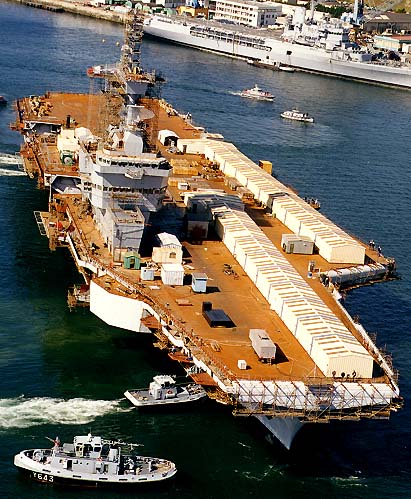
Rientro nel bacinodi carenaggio
Nel febbraio 2017, dopo quindici anni di servizio, la nave entra nel bacino di carenaggio di Tolone per interventi di manutenzione che dovrebbero concludersi negli ultimi mesi del 2018 ed estendere la vita operativa della nave di circa 20 anni. Durante questi lavori verranno implementati i sistemi di combattimento e sarÓ completato il passaggio ad una linea di volo composta solamente da Rafale. Fino a quando i lavori non saranno ultimati, l'italiana Cavour (C 550) sarÓ la sola portaerei europea operativa.
La portaerei Ŕ entrata nel bacino di carenaggio nel febbraio 2017 lasciandolo a maggio 2018 e alla fine di luglio ha attraccato alla banchina operativa per le prove di accettazione. Ha quindi effettuato uscite in mare per le prove che devono essere eseguite in condizioni operative, con il supporto di altre unitÓ della Marina francese. Il termine ultimo di messa a disposizione della nave era il 16 ottobre 2018, al termine della completa ricertificazione dei sistemi. Il 14 novembre 2018, al termine dei test in mare, la portaerei Ŕ stata visitata dal Presidente Emmanuel Macron, che ha dormito a bordo dell’ammiraglia
The carrier replaced Foch, a conventionally-powered aircraft carrier, in 2001. Clemenceau and Foch were completed in 1961 and 1963 respectively; the requirement for a replacement was identified in the mid-1970s.
The hull was laid down in April 1989 at the DCNS Brest naval shipyard. The carrier was completed in May 1994 and at 35,500 tonnes was the largest warship launched in Western Europe since 1951. She was to be named Richelieu in 1986 by the French president at the time, Franšois Mitterrand, after the famous French politician Armand-Jean du Plessis, Cardinal and Duc de Richelieu (following a traditional name for capital ships in the French Navy, see battleship Richelieu for instance). On 7 February 1987, however, after a ferocious row, the name of the ship was changed to Charles de Gaulle by the Gaullist Prime Minister at the time, Jacques Chirac.
Construction quickly fell behind schedule as the project was starved of funding, which was worsened by the economic recession in the early 1990s.Total costs for the vessel would top €3 billion. Work on the ship was suspended altogether on four occasions: 1990, 1991, 1993 and 1995.The ship was commissioned on 18 May 2001, five years behind the projected deadline.
In 1993, it was alleged by the Guardian that a group of engineers inspecting the vessel during its construction were MI6 operatives, believed to have been evaluating the method of shielding the nuclear reactors, amongst other technical details.However, the newspaper published a denial by both the British government and the Direction de la Surveillance du Territoire that there had been any incident.
Satirical strip of Le Parisien newspaper. The sign reads : "Work in progress, slow down".
Charles de Gaulle entered sea trials in 1999. These identified the need to extend the flight deck to safely operate the E-2C Hawkeye. This operation sparked negative publicity, however, as the same tests had been conducted on both Foch and Clemenceau when the F-8E(FN) Crusader fighter had been introduced. The 5 million francs for the extension was 0.025% of the total budget for Charles de Gaulle project.
On 28 February 2000, a nuclear reactor trial triggered the combustion of additional isolation elements, producing a smoke incident.
During the night of 9 November 2000, in the Western Atlantic while en route toward Norfolk, Virginia, the port propeller broke and the ship had to return to Toulon to replace the faulty unit. The investigations that followed showed similar structural faults in the other propeller and in the spare propellers: bubbles in the one-piece copper-aluminium alloy propellers near the centre. The fault was blamed on the supplier, Atlantic Industries, which had already gone bankrupt. To make matters worse, all documents relating to the design and fabrication of the propellers had been lost in a fire. As a temporary solution, the less advanced spare propellers of Clemenceau and Foch were used, limiting the maximum speed to 24 knots (44 km/h) instead of the contractual 27 knots (50 km/h).
On 5 March 2001, Charles de Gaulle went back to sea with two older propellers and sailed 25.2 knots (47 km/h) on her trials. Between July and October, Charles de Gaulle had to be refitted once more due to abnormal noises, as loud as 100 dB, near the starboard propeller, which had rendered the aft part of the ship uninhabitable.
On 8 November 2001, a sailor performing a routine maintenance task lost consciousness due to a toxic gas leak. A non-commissioned officer attempted to rescue him and collapsed as well. They were immediately rescued by the on-board medical team and sent to Toulon Hospital. Both survived.
Command bridge of Charles de Gaulle
On 16 September 2001, the French press reported slightly higher than acceptable radioactivity levels aboard Charles de Gaulle, thought to be caused by a faulty isolation element. It was later discovered that the radioactivity levels were normal, but that the regulations concerning acceptable radioactivity levels had changed. While the United States was preparing its response to the September 11, 2001 attacks in the form of Operation Enduring Freedom, the media complained about the lack of deployable French military power. At the same time, the Defence Commission reported the maintenance of the Fleet to be substandard. In this context, Charles de Gaulle, then under repairs, was again an object of criticism, with former President ValÚry Giscard d'Estaing describing it as a "half-aircraft-carrier".
On 11 October 2001, the frigate Cassard, four AWACS aircraft and Charles de Gaulle were involved in a successful trial of the Link 16 high-bandwidth secure data network. The network allows real-time monitoring of the airspace from the South of England to the Mediterranean Sea. The collected data were also transmitted in real time to the Jean Bart through the older Link 11 system.
A rare occurrence of a 5-country multinational fleet of the NATO countries, the Netherlands, France, the United States, Italy, and the United Kingdom, during Operation Enduring Freedom in the Oman Sea
On 21 November 2001, France decided to send Charles de Gaulle to the Indian Ocean in support of Operation Enduring Freedom against Taliban-controlled Afghanistan. Task Force 473, with 2,900 men under the command of Contre-Amiral Franšois Cluzel, sailed on 1 December. The task force was composed of Charles de Gaulle, frigates La Motte-Picquet, Jean de Vienne and Jean Bart, the nuclear attack submarine Rubis, the tanker Meuse and the aviso Commandant Ducuing.
Embarked air power comprised sixteen Super ╔tendards, one E-2C Hawkeye, two Rafale Ms and several helicopters. The Super ╔tendards carried out their first missions above Afghanistan on 19 December, executing reconnaissance and bombing missions, covering over 3,000 kilometres. Overall they carried out 140 missions, averaging 12 every day, dodging five Stinger missiles.
On 18 February 2002, a Helios observation satellite spotted abnormal activities near Gardez. The next day, after American Special Forces in the region confirmed these observations, Charles de Gaulle launched two reconnaissance Super ╔tendards. On 20 February, British and US forces entered the valley and Operation Anaconda began in early March.
In March, Super ╔tendards and six Mirage 2000 aircraft carried out airstrikes against targets claimed to be al Qaeda. A few targets suggested by US forces were denied out of fear of hitting civilians. Nevertheless, French involvement was complimented on 11 March 2002 by US President George W. Bush, who mentioned "our good ally, France, has deployed nearly one-fourth of its navy to support Operation Enduring Freedom".At this point, the French air complement had been increased to 16 Super ╔tendards, 6 Mirage 2000 D, 5 Rafales, and two Hawkeye AWACS. From February, the air wings of Charles de Gaulle and USS John C. Stennis landed on each other's decks as a means of strengthening the ties between the allies.
On 2 May, Charles de Gaulle arrived in Singapore for relief and returned to Oman on 18 May.
In June 2002, according to several reports,while Charles de Gaulle was in the Arabian Sea, armed Rafale fighters participated in interposition patrols near the India-Pakistan border, marking a significant point in the Rafale M's operational career and its integration with the carrier. A number of sources have speculated on the exact nature and purpose of these flights.
On 9 October, the CrossMed (The Regional Operational Centre for Monitoring and Rescue in the Mediterranean Sea) received a distress call from the 8-metre Babolin, whose hull was leaking. Charles de Gaulle, on maneuvers in the region, sent a helicopter that airlifted the three-man crew, despite 35-knot (65 km/h) wind, troubled sea, and bad visibility.
Charles de Gaulle participated in further actions as part of Operation Enduring Freedom in 2005. It returned to Southwest Asia in May 2006 and shortly after supported coalition efforts over Afghanistan. The aircraft carrier regularly participates in the annual bilateral naval exercises between the Indian and French navies called 'Varuna'.
Charles de Gaulle's first major overhaul began in September 2007. The highlight of this 15-month refit was the refueling of the nuclear power plant, a necessary step after 6 years in service, during which Charles de Gaulle sailed the equivalent of 12 times around the world, spent 900 days at sea, and performed 19,000 catapult launches. Several improvements will also be made, including the installation of new propellers. These will allow the Charles de Gaulle to reach its design speed of 27 knots, replacing the vintage propellers used as a stop-gap since 2001. Aircraft maintenance and weapons stores will also be upgraded to allow operation of new Rafale F3 fighters armed with ASMP-A nuclear missiles and SCALP EG cruise missiles, and satellite communications bandwidth will be increased tenfold. The refit was completed in December 2008 but following technical problems in March 2009 the carrier is back in Toulon for repairs. An intensive work-up period is planned to bring the Charles de Gaulle and its airgroup back to operational status.
The French Navy is theoretically a two-carrier navy, mainly to ensure that at least one ship is operational at all times even if the other is under repair. This scheme requires another aircraft carrier to be built though, as the Charles de Gaulle is the only aircraft carrier currently serving.
Cost considerations have made equipment standardization a necessity. In this context, there is a possibility of collaboration with Britain for future aircraft carriers and France has purchased the design for the Queen Elizabeth class aircraft carrier, which may be modified as the Future French aircraft carrier. Steps have been taken by both countries to make such a scenario possible: the new carrier had to be conventionally propelled to meet the requirements of the Royal Navy, and while the French Navy favoured a nuclear design, French President Jacques Chirac declared at the end of 2004 that the next French carrier would use a gas turbine engine.
PORTAEREI DE GAULLE / AIRCRAFT CARRIER DE GAULLE
PORTAEREI NELLA STORIA / AIRCAFT CARRIERS
NAVI DA GUERRA / WARSHIPS AND BATTLESHIPS